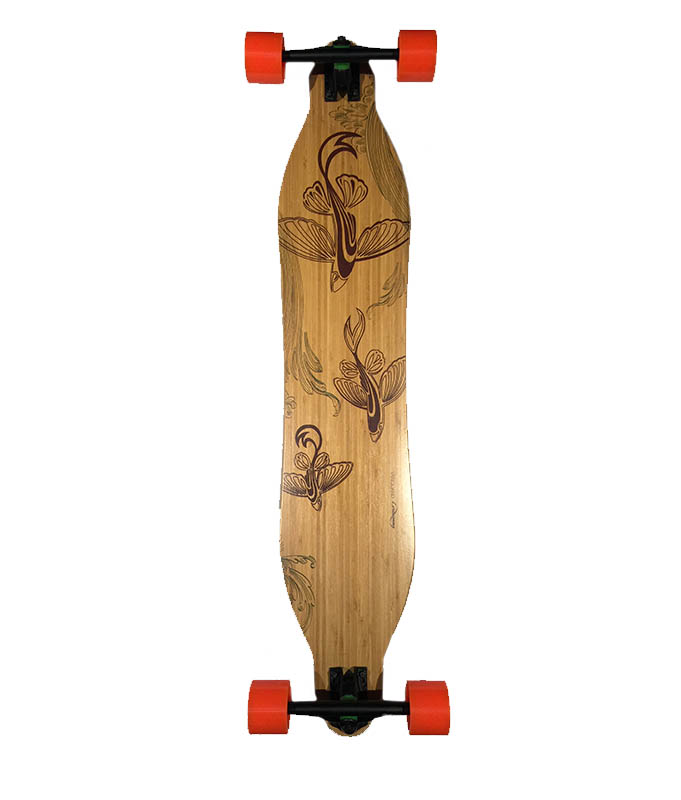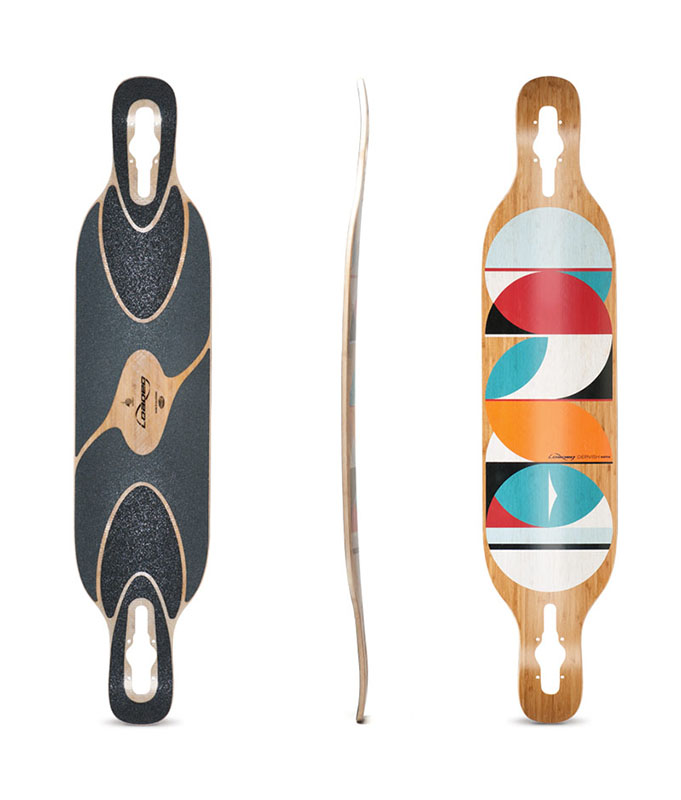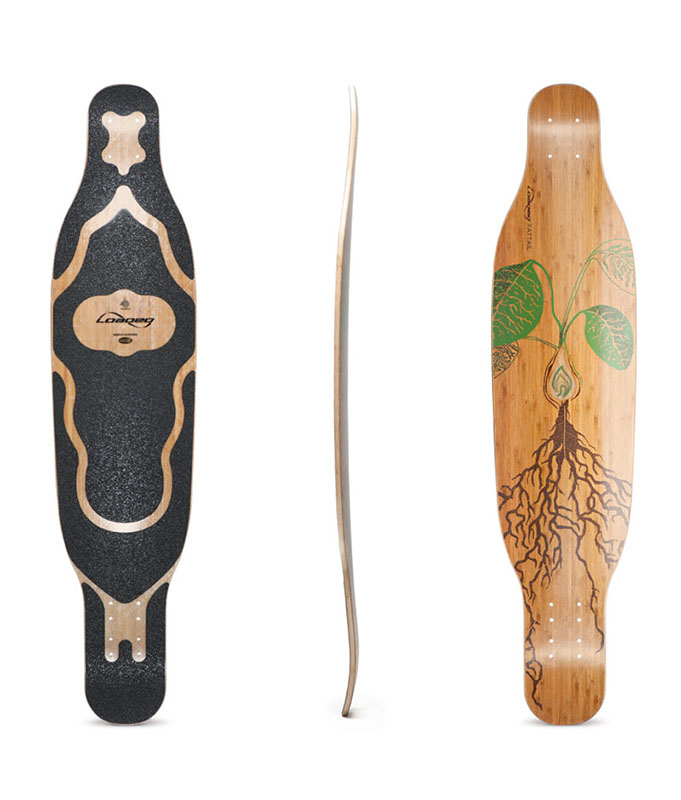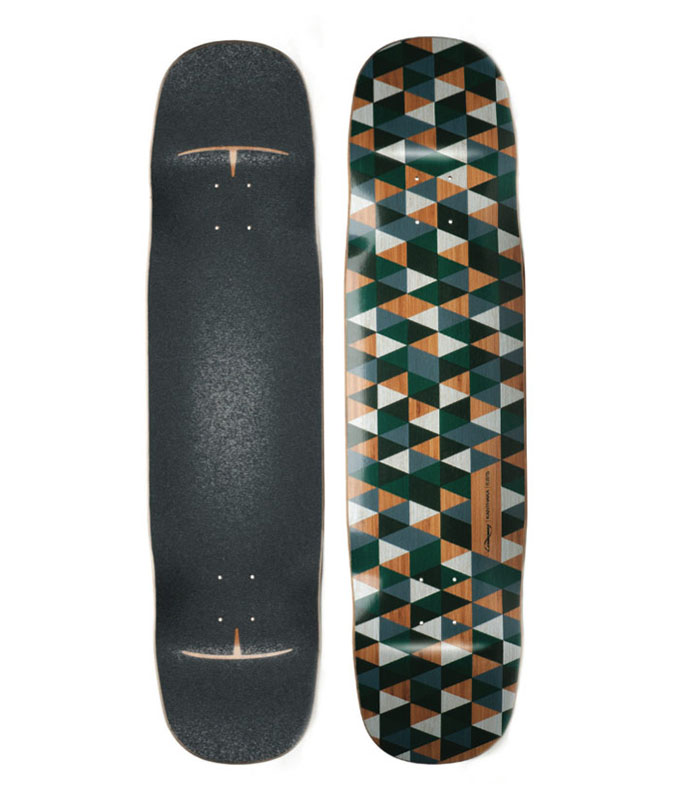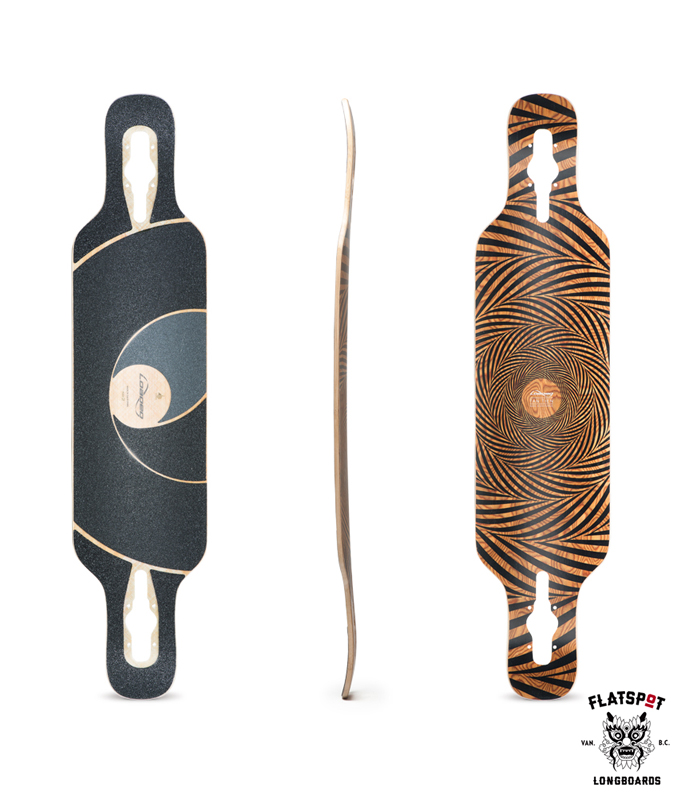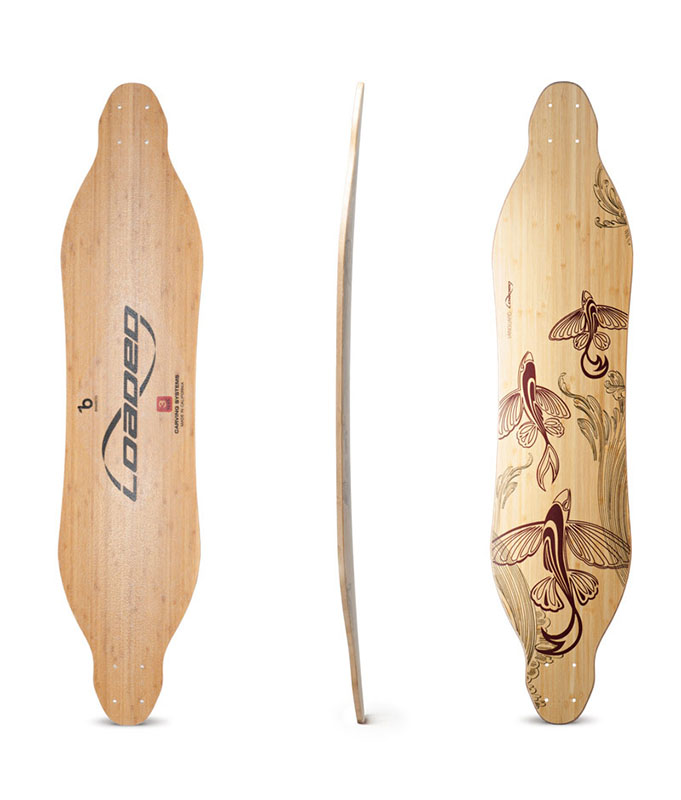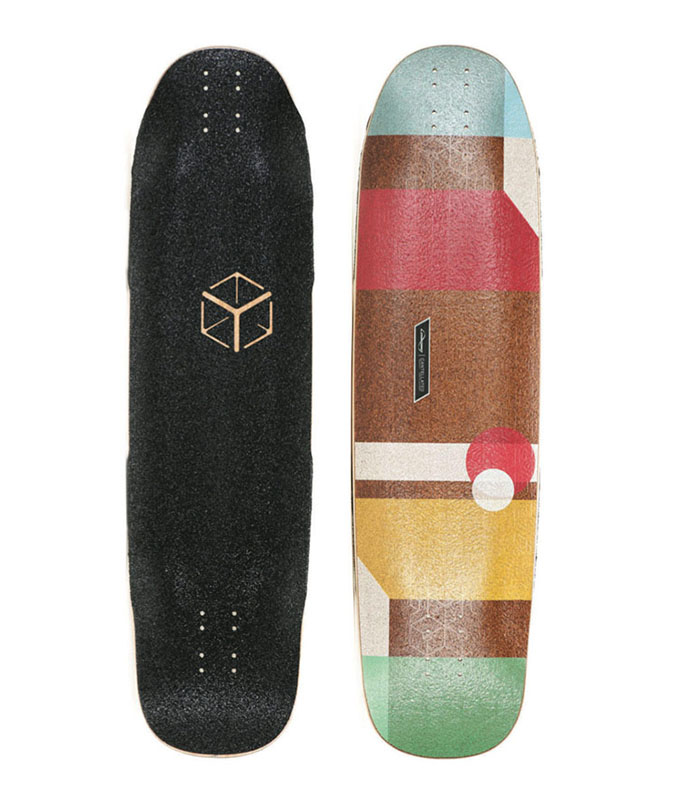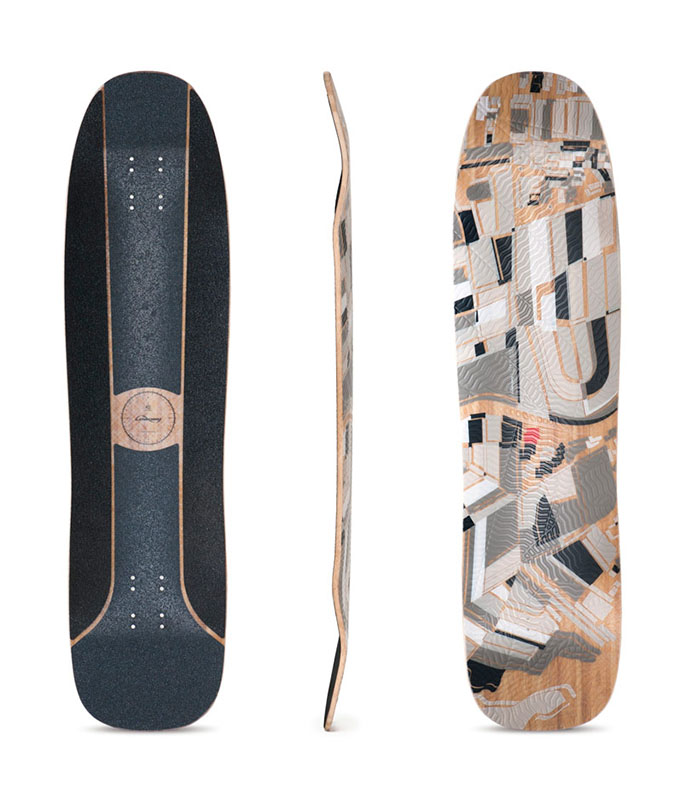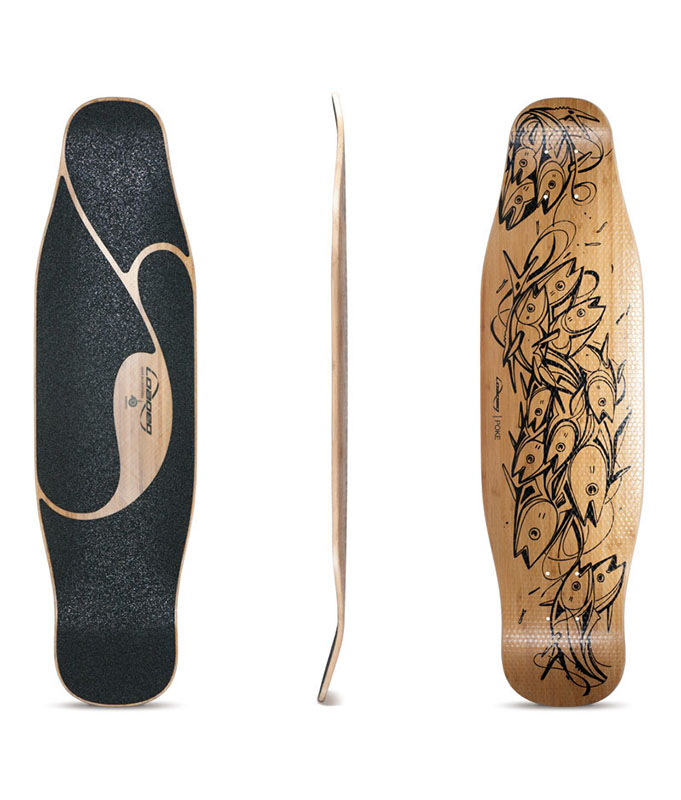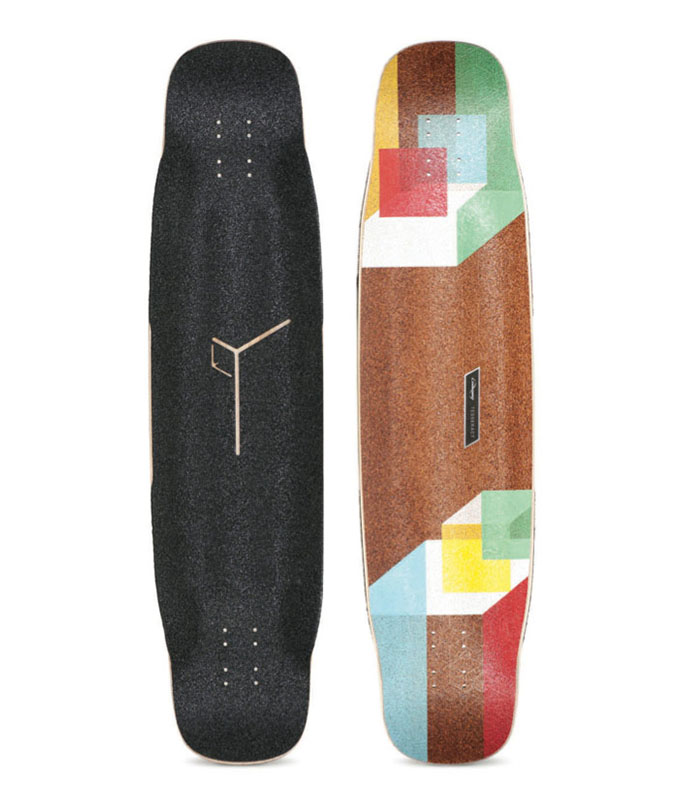- No products in the cart.
Search Results for: loaded
Loaded – Dervish – Deck
In 2007, the Dervish was our first venture into dropthrough construction and an opportunity to create a flexy, bamboo composite carver with the versatility to handle a variety of riding styles. Five years later, we’ve revisited this flagship board with new performance aspirations in mind.
With a slightly wider platform than its predecessor, the Dervish Sama balances comfort, edge control, and responsiveness. Combined with a more pronounced concave profile, the extra width enhances turn initiation and slide control. We added subtle nose and tail kicks to increase pop and lock your feet in for freestyle tricks. The neck and dropthrough cutout were also updated for increased durability under hard riding. A six-piece griptape pattern provides enhanced control at the kicks and facilitates comfortable footwork maneuvers on the standing platform without interfering with the board’s flex pattern.
Length: 42.8″ / 109 cm
Width: 9″ / 22.9 cm
Wheelbase: 31.5″ / 80 cm
Weight:
Deck: 3.0 – 3.6 lbs / 1.4 – 1.6 kg
Complete: 7.0 – 7.6 lbs / 3.2 – 3.4 kg
FLEX
Flex 1: 170-270+ lbs / 75-122+ kg
Flex 2: 100-185+ lbs / 45-84+ kg
Flex 3: 75-150+ lbs / 35-68+ kg
SHAPE
Using sophisticated \(for us\) design software and curvature calculations, we extensively tested various different widths and subtle changes to the deck shape. We then collectively decided that this new 9\” wide shape \(the old Dervish was 8.5\” with a different neck curvature\) provided a satisfactory balance of comfort, edge control, and responsiveness.
CONCAVE
The Dervish Sama also received a more pronounced concave profile, which is further augmented by the increased deck width. The result is improved edge feel for turn initiation and extra control while sliding.
NOSE & TAIL KICKS
To keep up with the current caliber of freestyle riding, we gave the Dervish the most tasteful of nosejobs. After testing several new shapes and sizes, we lengthened the tips for additional leverage, widened the neck to increase durability and ensure a consistent flex pattern through the entire deck, and added subtle kicks to increase pop and to lock your feet in. The kicks are reinforced with an extra layer of fiberglass for added stiffness and durability.
GRIPTAPE
A six-piece symmetrical griptape pattern was designed with performance and elegance in mind. The two sections at the kicks use an aggressive, rougher-grit grip to provide enhanced control and security for manuals and freestyle tricks. The four middle sections use a milder, finer-grit grip \(comparable to street skate grip\) to facilitate dancing and footwork maneuvers. The segmented design yields functional coverage without interfering with the boards flex pattern.
CAMBER
The Dervish Sama’s versatility lends it to many disciplines, but at its heart lies a deeply rooted passion for carving. The cambered platform and weight-tailored flex pattern work together synergistically to provide a lively, flowing ride. Press your weight into a turn to preload the deck’s curvature; unweight as you finish the carve and feel the board snap back with positive energy return.
FLEX
Flex 1: 170-250+lbs / 75-114+kg
Flex 2: 100-185+lbs / 45-84+kg
Flex 3: 75-150+lbs / 35-68+kg
Keep in mind that a softer flex pattern will give you more control and tighter turns at slower speeds and make it easier to slide, but tends to lose stability slightly at higher speeds. Stiffer flex means more energy potential, more stability at higher speeds, and makes air moves easier, but will not be as forgiving and lively when cruising.
NAME & GRAPHICS
Continuing our exploration in color theory and geometry, we looked deeper into Bauhaus principles to create this homage to the circle. By exposing multiple forms over one another, we were able to exemplify the arcing and flowing movements possible on this carving board and honor the whirling and spiritual experience debuted by its namesake. Lean this board against your Breuer chair or boardslide it into a custom work of art; either way, we think you will enjoy the new Dervish Sama.
CONSTRUCTION
Epoxy and triaxial fiberglass sandwich a vertically laminated bamboo core, pressed into concave and convex cambers for liveliness, responsiveness and high energy potential. Drop-through cutouts are CNC milled for precision.
HISTORY
In 2007, the Dervish was our first venture into dropthrough construction and an opportunity to create a flexy, bamboo composite carver with the versatility to handle a variety of riding styles. Five years later, we’ve revisited this flagship board with new performance aspirations in mind.
With a slightly wider platform than its predecessor, the Dervish Sama balances comfort, edge control, and responsiveness. Combined with a more pronounced concave profile, the extra width enhances turn initiation and slide control. We added subtle nose and tail kicks to increase pop and lock your feet in for freestyle tricks. The neck and dropthrough cutout were also updated for increased durability under hard riding. A six-piece griptape pattern provides enhanced control at the kicks and facilitates comfortable footwork maneuvers on the standing platform without interfering with the board’s flex pattern.
by Cameron Frazier - Categories:
Loaded Boards – Fattail – Deck
A little extra girth never hurt anyone. At least that was our approach when it came time to revamp the design of the Pintail. We wanted to modernize this classic concept so it could keep up with evolutions in riding and performance.
The Fattail was designed for pumping, carving, pedestrian slalom, freestyle and generally any situation where lively, energetic lines are on the menu. Increased concave locks your feet in against g-forces, while the topmounted and cambered platform provides energetic performance in and out of each carve. The width of the deck has been redistributed while maintaining subtle tapering near the trucks to provide both ample leverage and awareness of foot position while powering through turns. The formerly vestigial tail has received the silicone treatment for improved functionality in both freestyle tricks and surf-style shredding. The Fattail is also equipped with a slight nose kick for manuals and shuvits.
LONGBOARD SPECS
Length: 38″ / 96.5cm
Width: 8.63″ / 22cm
Wheelbase (Inner): 26.5″ / 67.3cm
Wheelbase (Outer): 27.4″ / 69.6cm
Weight:
Deck: 3.bs / 1.4kg
Flex
Flex 1: 170-270+ lbs / 75-122+ kg
Flex 2: 125-215+ lbs / 55kg-95kg
Flex 3: 75-175+ lbs / 35kg-80kg
CAMBER
Big and lively camber is the heart and soul of the Fattail. A carvy pumper at heart, the Fattail was designed with a healthy amount of camber to provide snowboard like responsiveness in a pocket sized package.
CONCAVE
A nominal concave provides a locked in feel and stiffens the deck without undermining the camber and flex characteristics of the board.
FLEX
We currently offer three flexes spread out over two lengths.
Flex 1: Up to 275 lbs/ <125kg
Flex 2: 125-215+ lbs/55kg – 95kg
Flex 3: 75-175+ lbs/35kg-80kg
A softer flex pattern will give you more control and tighter turns at slower speeds, however a softer board is more prone to lose stability at higher speeds.
If you plan on doing a lot of hard-pounding tricks like shovits and bonelesses, a stiff flex will hold up better. Note: It is natural for the boards to break in and become slightly flexier over time.
DIRECTIONAL SHAPE
An organic tapering shape preserves torsional stiffness and allows both heels and toes to maintain constant contact with the rails for optimal control in hard carving and pumping. Lots of clearance for big, fast, and grippy wheels.
NAME & GRAPHICS
The Fattail graphic is an extension of the artistic concept explored in the two graphics used on the Pintail. The first graphic was designed by Jamie Engelman in 2004 as a meditation on change and growth. It was re-imagined more abstractly by Jan Michael Bennett in 2006 when we switched the Pintail from oak to bamboo. The current graphic was designed by Nana Studio (based on drawings by Daisuke Okamoto) and references the previous designs while expanding on the underlying concepts.
HISTORY
The Pintail was released in June of 2004 two years after the release of the Vanguard and a year after the release of the now defunct Fish and Hammerhead. At that point (and for a number of years following), Loaded was an uphill battle and the future was not looking too bright. Our boards were criticized for being too strange looking and quirky. We felt that form should follow function, but if we were to survive we needed to compromise aesthetically and create something more “traditional” looking. We therefore designed the standing platform of the Pintail with performance as the only design intent (at the time we had just started re-exploring tapered platforms) but let our love of surf and surf culture inspire the design for the nose, rear cutaway and tail. As of today, we’re stoked to be leaving this one foray into tradition-based aesthetics behind (and, in the process, creating a more functional and possibly more beautiful board in all regards). That said, one of the primary reasons we called this board the Fattail is as a reminder of what it has taken to get to where we are.
CONSTRUCTION
A vertically-laminated bamboo core is sandwiched between fiberglass skins. The tail is reinforced with an additional layer of fiberglass (top) and carbon fiber (bottom) for added stiffness and abrasion resistance. The bottom is finished with a bamboo veneer with a die cut water droplet pattern, which is filled with transparent urethane and a “floating” graphic to give a sense of dimensionality.
by Cameron Frazier - Categories:
Loaded – Kanthaka – Deck
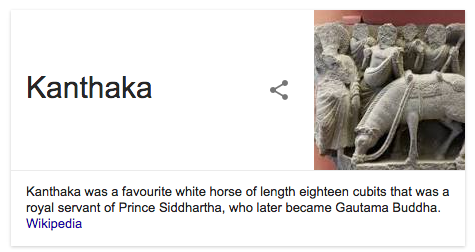
Thanks google. Well, there you have it. The Loaded Kanthaka was the trusty steed of the Holy Buddha. Maybe this is alluding to how skateboarding is meditative, and somehow aids in ones pursuit of enlightenment. Maybe its just a sweet name that sort of sounds like an asian sword. Either way, its a sweet deck that shines most tech sliding, due to its flare wheel wells and deep concave. But is more than suitable for bowls and parks. The bamboo fibreglass construction make it super stiff, and if you rock a set of tail guards to prevent razer tail it will last basically forever.
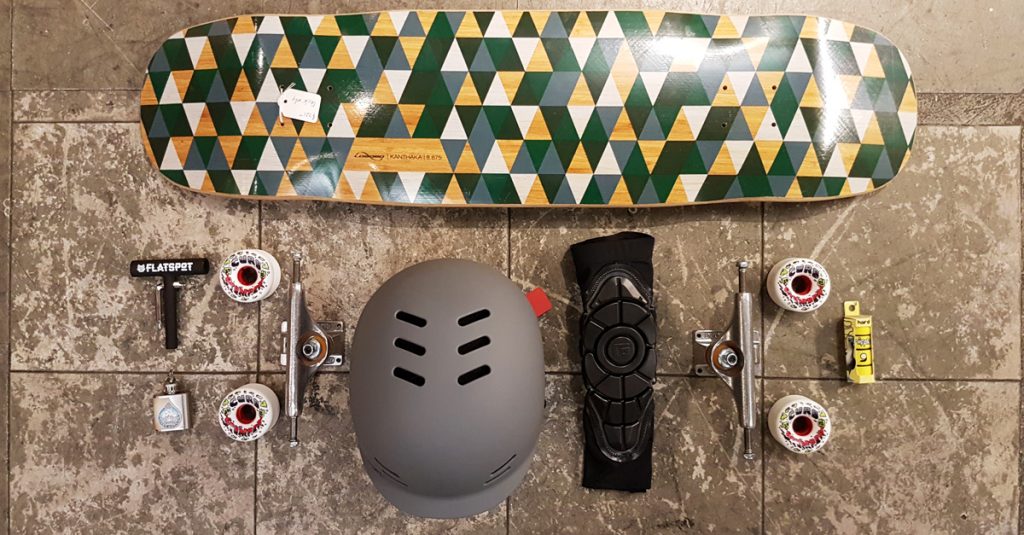
Available in Wide and Narrow
Length: 36” (91.44cm)
Width: 8.625” (21.908cm) OR 8.875” (22.416cm)
Wheelbase: 17.5” (44.45cm)
Kick length: 7.5” (19.05cm) tip to inner bolt
by Cameron Frazier - Categories:
Loaded – Tan Tien – Deck
The Tan Tien blends carve-oriented longboarding with advanced trick riding. A flexible deck, drop-through truck mounts and usable kicks allows the Tan Tien to pack a lot into a relatively small package. The complex contours create a super responsive board that allows for increased confidence when leaning into turns, popping tricks, and powering through slides.
Lines are fluid. Directions are malleable.
The updated grip design and bottom veneer (Dec. 2016) reference the history of the Tan Tien and its conceptual underpinnings. It’ll also make your home smell of many leather bound books.
Length: 39″ / 99cm
Width: 8.75″ / 22.25cm
Wheelbase (Inner Hole): 27″ / 68.5cm
Weight:
Deck: 3.1 – 3.5lbs / 1.4-1.6kg
Complete: 6.6 – 7lbs / 3 – 3.2kg
FLEX
Flex 1: 170-270+ lbs / 75-122+ kg
Flex 2: 130-210+ lbs / 59-95+ kg
Flex 3: 80-170+ lbs / 36-77+ kg
GRIP TAPE
The Tan Tien is pre-gripped with an aggressive black griptape designed to provide enhanced traction and control for sliding, pumping, and freestyle tricks. The functional, orbiting griptape pattern allows the board to flex naturally without compromising traction.
FLEX
Flex 1: 170-270+ lbs / 75-122+ kg
Flex 2: 130-210+ lbs / 59-95+ kg
Flex 3: 80-170+ lbs / 36-77+ kg
Keep in mind that a softer flex pattern will give you more control and tighter turns at slower speeds and make it easier to slide, but tends to lose stability slightly at higher speeds. Stiffer flex means more energy potential, more stability at higher speeds, and better longevity through abusive tricks and aerial landings, but will not be as forgiving and lively when cruising. The Flex 1 is considerably stiffer so as to be appropriate for heavier riders and hardpounding thrashers alike.
SHAPE
A symmetrical deck shape allows for ambidextrous carving and freestyle trickery, while full wheel cutouts provide plenty of clearance for deep carving.
CONCAVE
Subtle concave enhances edge feel for turn initiation and slide control.
NOSE & TAIL KICKS
Minimalist nose and tail kicks allow for manuals and freestyle tricks. Reinforced with an extra layer of fiberglass for added stiffness and durability.
CAMBER
The Tan Tien’s cambered profile and rigid outline shape spring you out of every carve with power and flow; the more you give, the more you get.
HISTORY & GRAPHICS
The Tan Tien is the center of gravity and the seat of the life force in yogic and East Asian thought.
Driven by progressive longboarding as explored by Loaded’s riders, the Tan Tien was launched in 2010 from a desire to develop new tricks and engage new riding styles. It was the first board that employed nose and tail kicks on a flexible drop-through deck.
When launching the original Tan Tien, we used a hand-woven bamboo veneer with a small center star graphic (designed by Nana Studio) to explore the centrifugal nature of the conceptual Tan Tien. We had technical issues with the woven veneer and in 2012 we ended up working with Los Contratistas to design a new (also centrifugal) graphic on a standard bamboo veneer. We missed the simple beauty of the woven veneer, and in December 2016 we spun full circle and re-launched the Tan Tien with its new engineered veneer and orbital griptape pattern. The varied “topographic high points” in the veneer reflect the fact that all Tan Tien riders share a common soul and are controlled by a hive mind.
CONSTRUCTION
Epoxy and triaxial fiberglass sandwich a vertically laminated bamboo core, which is finished with a multi-centered “engineered” wood veneer and pressed into concave and convex cambers as well as nose and tail kicks. The nose and tail are reinforced with an extra layer of fiberglass for added stiffness and strength without compromising the responsiveness and energy of the central camber. Drop-through cutouts are CNC milled for precision.
by Cameron Frazier - Categories:
Loaded – Vanguard – Deck
The one that started it all. Symmetrical shape and stance for a balanced center of gravity to increase the ability to weight the deck through turns for better control and energy generation. The sidecuts allow for decreased torsional stiffness between the feet to exploit the board’s torsional energy to allow for greater nuances in the turning radius.
The Vanguard was designed and intended for speeds between 0 and 25 mph (0-40km/hr). You can take the board faster with skill and experience, but it is not intended for higher speeds due to its flex characteristics.
Length: 42″/107cm & 38″/98cm
Width: 8.5″/21.5cm
Wheelbase: 35″/88.9cm & 31.5″/80cm
Deck Weight: 2.7 – 3.8lbs / 1.2 – 1.7kg
FLEX
Flex 1 (42″/107cm): 175-230+lbs / 80-105+kg
Flex 2 (42″/107cm): 150-210+lbs / 68-95+kg
Flex 3 (38″/98cm): 150-200+lbs / 68-90+kg
Flex 4 (38″/98cm): 120-170+lbs / 55-77+kg
Flex 5 (38″/98cm): 80-140+lbs / 35-65+kg
CAMBER
Big and lively camber is the heart and soul of the Vanguard. A carvy pumper at heart, the Vanguard was designed with a healthy amount of camber to provide snowboard like responsiveness in a pocket sized package.
CONCAVE
A nominal concave provides a locked in feel and stiffens the deck without undermining the camber and flex characteristics of the board.
GRIPTAPE
A highly carve-oriented board, the Vanguard features a clear spray grip made of recycled crushed glass. This style of grip allows for full coverage over the entire board without impacting its vital flex characteristics. Additionally, it exposes the beauty of the materials and construction.
FLEX
We currently offer five flexes spread out over two lengths.
Flex 1: 175-230+lbs / 80-105+kg 42\”/107cm
Flex 2: 150-210+lbs / 68-95+kg 42\”/107cm
Flex 3: 150-200+lbs / 68-90+kg 38\”/98cm
Flex 4: 120-170+lbs / 55-77+kg 38\”/98cm
Flex 5: 80-140+lbs / 35-65+kg 38\”/98cm
A softer flex pattern will give you more control and tighter turns at slower speeds, however a softer board is more prone to lose stability at higher speeds.
If you plan on doing a lot of hard-pounding tricks like shovits and bonelesses, a stiff flex will hold up better. Note: It is natural for the boards to break in and become slightly flexier over time.
HISTORY
The one that started it all. Symmetrical shape and stance for a balanced center of gravity to increase the ability to weight the deck through turns for better control and energy generation. The sidecuts allow for decreased torsional stiffness between the feet to exploit the board’s torsional energy to allow for greater nuances in the turning radius.
The Vanguard was designed and intended for speeds between 0 and 25 mph (0-40km/hr). You can take the board faster with skill and experience, but it is not intended for higher speeds due to its flex characteristics.
CONSTRUCTION
Epoxy and triaxial fiberglass sandwich a vertically-laminated bamboo core, pressed into concave and convex cambers for liveliness, responsiveness and high energy potential.
by Cameron Frazier - Categories:
Loaded – Cantellated Tesseract – Deck
The Tesseract family has expanded to cater to your unique quest for four-wheeled illumination. The Cantellated Tesseract integrates rocker, wheel well flares, W concave, and multiple wheelbase options into a lightweight package designed for big mountain roads, high speeds, snappy slides, lofty ollies, and techy manual combos. It sports a single tail kick to meet your ollie-popping, tick-tacking, and manual-balancing needs. The Cantellated Tesseract’s tail features a wider and fuller shape that promotes more frequent and emphatic use than its double-kick cousin. Escape the three-dimensional confines of contemporary skateboarding and embrace the fourth dimension.
Length: 36” / 91 cm
Width: 9.5” / 24 cm
Wheelbase: 24.5” and 26” / 62.2 cm and 66 cm
Tail: 7.25” / 18.4 cm (tip to inner bolt on 24.5” wheelbase)
Concave: 0.30” / 0.76 cm (at W peak), 0.39” / 0.99 cm (at W trough)
Rocker: 0.33” / 0.84 cm
Wedging angle: 3.5°
Weight: 4.5 lbs / 2.0 kg (with grip)
ROCKER
Symmetrical rocker throughout the deck cups the outer edges of your feet and creates a subtle locked-in sensation, helping you stay firmly planted in slides and facilitating confident and natural movement up and down the length of the board. Additionally, rocker slightly lowers your center of gravity for enhanced stability.
WHEEL WELL FLARES
Flared wheel wells increase wheel clearance and also create surface transitions that provide lateral and longitudinal support for your feet, both inside the trucks and on the kicktail. These flares promote board awareness and keep your feet locked into a compound contoured pocket while sliding, cornering, and tucking.
W CONCAVE
The Tesseract family features an intuitive W concave to enhance rider control in all toeside maneuvers. The central hump is tall yet wide, providing strong lateral support near the transitions without compromising arch comfort. The W concave follows a mellow elliptical shape and fades gradually in amplitude approaching the trucks, disappearing 3/4″ behind the innermost mounting holes. This design allows the inside edges of your feet to nestle up against the W (for toeside slides) while also allowing the outside of your foot to rest in a more radial dish just behind the flared wheel wells (for comfort while tucking on long downhill runs). Progressive yet mild rail concave provides optimal edge control without sacrificing comfort.
DIRECTIONAL SHAPE
The Cantellated Tesseract sports a single tail kick to meet your ollie-popping, tick-tacking, and manual-balancing needs. The kick length — tuned for maximum functionality and pop in the original Tesseract — remains unchanged. However, the Cantellated Tesseract’s tail features a wider and fuller shape than its double-kick cousin. The width of the board stays consistent all the way up to the blunted nose for predictable leverage for slides and tricks anywhere on the board.
VARIABLE WHEELBASE
24.5″ and 26″ wheelbase options allow you to fine tune your setup based on your riding style and specific truck geometry. Move your axles in for quicker pop, increased agility, higher traction, and lower swing weight; move them out for greater stability and more lean.
GRAPHICS
When presented a cork canvas to work on, two distinct reference were evident. One was a grandparents’ mid-century cork lamp (strangely out of place in their Francophile home). Second, was an interest and training in the International (Swiss) Style. Given the complexity and diversity of the board, a pursuit of simplicity in the design was in order. A focus on a solid color field cube created interesting and organic looking opacity changes when printed on the cork. This play with natural textures against the contrived cubic print creates an emphasis on the craft of the board as a whole.
WHEELS
The Cantellated Tesseract’s powerful pop and lightweight construction pair best with a light and small wheel for freestyle and technical freeride enthusiasts. We ride Orangatang Fat Frees (65mm) or Keanus (66mm) to keep the ollies high and swing weight low. Scale up to a mid- to high-diameter wheel such as Orangatang Kilmers (69mm), Stimulus (70mm), Morongas (72.5mm), Cages (73mm), or Durians (75mm) for higher roll speed, smoother performance on rough pavement, and increased longevity.
For downhill applications, the Cantellated Tesseract can accommodate up to an 80mm race wheel (such as the Orangatang Kegel). Be sure to fine tune your setup with the appropriate hardware (risers, bushings, washers) to provide the performance you’re after, and always check for wheelbite before you ride.
CONSTRUCTION
Two layers of custom fiberglass/epoxy skins sandwich two vertically-laminated bamboo cores to create a stiff yet light and damp structure. Laminated to the bottom of the board is a layer of cork which provides vibration damping and (as we learned to our surprise during testing) a significant level of durability. The granular, non-directional structure of the cork helps prevent abrasive damage from propagating (in contrast to a traditional wood or bamboo veneer with long, oriented fibers).
The tessellated pattern in the cork is generated in 4-dimensional space and can only be fully understood if you lick it.
by Cameron Frazier - Categories:
Loaded – Overland – Deck
Spanning the size gap between the Kanthaka and Tesseract, the Overland is designed for the all-around rider seeking a happy medium between a shorter technical double kick and a thoroughbred downhill freeriding machine.
Length: 37” (94cm)
Width: 9.5” (24cm)
Wheelbase: 20.75” and 22” (52.71 and 56 cm)
Rocker: 0.125″ / 0.318 cm
Concave: 0.50″ / 1.3 cm
Nose angle: 18°
Tail Angle: 13°
Nose: 4.9″ / 12 cm from outermost bolt
Tail: 5.9″ / 15 cm from outermost bolt
ROCKER
Slight rocker complements the board\'s subtle flex and allows you to sink into a comfortable hammock-like interface for both leisurely and aggressive riding. The rocker helps freestyle tricks feel more natural and also creates a solid platform for pushing and commuting. The rocker blends smoothly into the rear wheel well flares.
WHEEL WELL FLARES
Mild flares pressed into the deck increase wheel clearance while also serving as ergonomic reference points.
CONCAVE
The Overland features mild radial concave, slightly deeper near the front to lock your foot in and mellower in the back.
VARIABLE WHEELBASE
The Overland features two wheelbase options. The longer 22\” wheelbase is intended for reverse-kingpin trucks and provides additional stability for faster riding; the shorter 20.75\” wheelbase accommodates conventional trucks and allows for improved agility and responsiveness.
NOSE & TAIL KICKS
The longer rear kicktail has a shallower angle to facilitate ollies and no-complies. A wider shape also provides ample leverage for bluntslides and tail-heavy freeriding. The shorter and steeper nose is better suited for nollie freestyle tricks, nose manuals, and leveling out ollies.
FLEX
The Overland features a moderately rigid flex. The directional shape causes the flex pattern to feel stiffer near the front and slightly looser near the back, maintaining an energetic feel while pumping and hard carving without compromising the board\'s high-speed stability or sliding response.
GRIPTAPE
The Overland is equipped with coarse griptape along the rails for optimal edge control in aggressive sliding and pumping maneuvers. A strip of mellower grip down the centerline of the board allows for less abrasive ollies and street freestyle tricks.
DIRECTIONAL SHAPE
Old-school nostalgia meets modern functionality. The Overland\'s \'80s pool-style shape is wider in the front for lots of leverage and narrower in the back for quicker rail-to-rail foot movement while sliding and cornering. The hourglass waist accentuates the wheel well flares for better tactile feedback in slides. The kicktail is large and in charge for primarily directional riding.
THERMOPLASTIC URETHANE BASE
Epoxy and triaxial fiberglass sandwich a 5-part vertically laminated bamboo core, pressed into concave and convex cambers for liveliness, responsiveness and high energy potential. Drop-through cutouts are CNC milled for precision.
A TPU bottom sheet provides vibration damping and protects the board against abrasion. Additionally, the low-friction material glides easily over rough surfaces, allowing for more effortless boardslides and tailslides.
GRAPHICS
The Overland takes its name from a major avenue in the LA Westside connecting Culver City in the south with Rancho Park in the north. The board's graphic is an illustration of this region (with the Loaded office highlighted in red). The textured pattern in the urethane bottom sheet is a topographical map showing the undulating elevation gradients in our very own backyard.
HISTORY
The Overland was inspired by our ambassadors searching for a board that could keep up with the variety of terrain underfoot. While the Kanthaka focused more on technical freeriding and street tricks and the Tesseract was sized to handle the demands of faster downhill runs, we quickly became aware of a small but enticing niche of riding styles that prompted the creation of a true middle-of-the-road vehicle. And thus the Overland was born to tackle freestyle, natural and man-made transitions, neighborhoods, and mild downhill–all in a strong and lightweight package.
CONSTRUCTION
The Overland features a vertically laminated bamboo core sandwiched between fiberglass skins and finished off with a bottom layer of textured thermoplastic urethane.
by Cameron Frazier - Categories:
Loaded Boards – Poke – Deck
Continuing the legacy of the Fish and Ceviche, the Poke is the newest phase of an evolving tradition. Featuring highly functional kicktails and a comfortable platform with concave, rocker, and wheel well flares, this versatile urban explorer keeps up with your every whim and makes each outing a creative, dynamic adventure.
Length: 34” / 86 cm
Width: 9.125” / 23.18 cm
Wheelbase: 20.75” / 52.71 cm
Tail: 7.625” / 19.37 cm (tip to inner bolt) @ 18°
Nose: 5.625” / 14.29 cm (tip to inner bolt) @ 13°
Concave: 0.5” / 1.3 cm (radial)
Rocker: 0.1” / 0.3 cm (centered)
CONCAVE
The Poke features 0.5″ of radial concave for solid and quick transitions from rail to rail while pumping, carving, and slashing. Aggressive enough for spirited performance riding yet comfortable enough for the casual commute or boogie through town.
ROCKER
The Fish and Ceviche were both designed with cambered profiles to promote a lively and responsive ride that helped to spring the rider out of hard, aggressive carves. While camber did achieve this goal, we decided to go with a nominal rocker on this incarnation in order to promote a more locked in feel and comfort in a broader range of riding styles. 0.1″ of rocker in the Poke’s standing platform complements the subtle flex of the board and allows you to sink into a comfortable hammock-like interface for both leisurely and aggressive riding. The rocker helps freestyle tricks feel more natural and also creates a solid platform for pushing and commuting.
WHEEL WELL FLARES
Slight concave flares on either end of the standing platform provide tactile reference for your feet, locking you in for quick maneuvers and promoting a high level of board awareness. Additionally, these complex contours enhance the torsional stiffness of the deck and promote better stability and control.
The Poke’s flares are much more subtle than those on the Kanthaka, Chubby or Tesseract, allowing for a comfortable interface for everything from commuting through thrashing.
KICKTAILS
The Poke sports an ample tail for assertive surf-style slashing and plenty of freestyle trickery. The kick angle has been tweaked from the Ceviche’s design to facilitate a quicker and more functional pop.
Moving up to the front of the board, the Poke’s nose has also been widened to create a more comfortable platform for manuals and shuvits. The neck areas between the standing platform and both the nose and tail have been broadened to provide more flexibility and security in foot placement.
DIRECTIONAL SHAPE
The Poke’s shape encourages an aggressive and surfy riding style with lots of drive from the back foot. Gentle cutouts help curb wheelbite without sacrificing comfort and control near the trucks.
NAME & GRAPHICS
The Poke’s graphic was designed by Tomas Guerena, a.k.a. Screw (www.screw.mx). Conceptually, the seafaring creatures illustrated represent lively organic chaos. The fish continues to embody the fluid, whimsical, and dynamic riding style we love to embrace on this board. And like a happy school of fish (or a big bowl of poke), this board is all about sharing in the experience and riding together with your closest companions.
The griptape pattern is cut with an aqueous pattern to subliminally instill an unhealthy obsession with the sea in the mind of the rider, thereby inspiring a surfy and fluid riding style.
HISTORY
The Ceviche was a beloved member of the Loaded family since its birth in 2008 and, like its ancestor the Fish, has inspired us and others to dart about on many a lightsome adventure. But over the years our ever-protean riding styles and tastes in equipment continued to metamorphosize, and by late 2011 we decided that the Ceviche, too, needed to evolve.
As we designed and tasted several rounds of prototypes, we quickly found that there were many desires at play. On one hand, we wanted to see the genealogy of the Fish and Ceviche take a new yet familiar form as a pumpable, agile, and trick-capable city commuter with just the right amount of flex. On the other hand, we also lusted after a stiffer, street-ready double-kick with inclinations toward freeriding and technical sliding.
The latter, as you may have guessed, materialized as the Kanthaka which we released in late 2012. And the former, led by our personal Beagle expedition to explore the origin of this species, has spawned as the Loaded Poke. The Ceviche has been discontinued, and Darwin is rolling in his grave.
The latest reincarnation of the Fish and Ceviche, mellow-mannered cousin of the Kanthaka, and little sibling to the Fattail, the Poke is driven by performance, ergonomics, and accessibility.
CONSTRUCTION
The Poke is built with a vertically-laminated bamboo core with triaxial fiberglass top and bottom skins and a bamboo base veneer. This construction allows for a strong, lightweight deck with responsive flex.
As this board is intended to spend plenty of time both under the feet and in the hands of longboarding freestylers and commuters, we decided to take this opportunity to experiment with new textural characteristics on the deck. The bottom bamboo veneer is sealed under a thin layer of hydrogenated bee pollen cured in a honeycomb pattern that lends a unique tactile quality to the Poke and can fight allergies. Conceptually, this is also a subtle allusion to fish scales and the Poke’s chordate lineage.
by Cameron Frazier - Categories:
Loaded Boards – Tesseract – Deck
Length: 39” / 99 cm
Width: 9.5” / 24 cm
Wheelbase: 24.5” and 26” / 62.2 cm and 66 cm
Nose & Tail: 7.25” / 18.4 cm (tip to inner bolt on 24.5” wheelbase)
Concave: 0.30” / 0.76 cm (at W peak), 0.39” / 0.99 cm (at W trough)
Rocker: 0.33” / 0.84 cm
Wedging angle: 3.5°
by Cameron Frazier - Categories:


